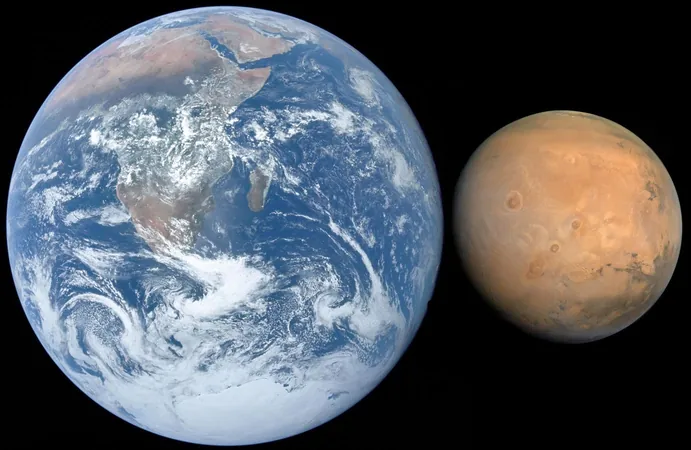
The Mystery of Mars: Why is the Red Planet So Small?
2024-12-30
Author: Amelia
Mars continues to baffle scientists, but not exclusively due to the commonly pondered questions of water presence or past life. The red planet's surprisingly small mass in comparison to Earth and Venus poses a significant puzzle that has intrigued planetary scientists for decades.
Mars boasts a mass approximately one-tenth that of Earth, leading to what Carnegie Institution scientist George Wetherill has dubbed the "small Mars" problem. Various theories have emerged to explain why Mars is smaller than its more massive neighbors, but few scientists are fully committed to any single explanation.
Johns Hopkins University's Matthew Clement expressed confusion over the lack of material near Mars during the early solar system that would have allowed it to grow to a size comparable to Earth and Venus. This raises an intriguing question: Could Mars' diminutive mass be the reason it failed to maintain surface water and ultimately became inhospitable?
Mass is a fundamental characteristic of any planet, emphasized Sean Raymond, an astrophysicist from the Bordeaux Astrophysical Laboratory in France. He stated that Mars' geological history and water loss directly correlate with its small mass, compounded by its distance from the Sun. That limited mass not only curtailed Mars' geological and volcanic activities essential for atmospheric replenishment but also rendered it vulnerable to atmospheric stripping by solar winds.
Interestingly, Mars managed to reach half its current mass very early in the solar system's formation. Consequently, any factors influencing size had to be established within the first few million years of the solar system's birth, as pointed out by Clement.
Three primary hypotheses attempt to clarify why Mars is significantly smaller than Earth:
1. The Grand Tack Model:
This theory proposes that the young Jupiter migrated inwards toward the Sun before reversing course and migrating back outwards. This migration likely disrupted the materials that could have coalesced into a larger Mars.
2. The Low-Mass Main Asteroid Belt Model:
This idea suggests that the region surrounding Mars had insufficient material to allow for substantial growth.
3. The Early Instability Model:
According to this hypothesis, the inner solar system experienced chaotic motion early on, preventing the formation of larger rocky planets beyond Earth and Venus.
It's plausible that a combination of these hypotheses contributed to Mars' small mass. Continued research and sampling of the Main Asteroid Belt are critical to discerning which theories hold the most merit.
Understanding the nuances of Mars' development is not merely an academic exercise; it holds vital implications for our broader understanding of planetary formation. The stark contrast among the four inner solar system planets sparks curiosity: Did something go awry for Mars, or did Earth just enjoy an advantageous position in the cosmic lottery?
Moreover, the fixation on Mars isn’t just due to its size but also its transformation process from cosmic dust to planet. Raymond suggests that ongoing research into how solar systems evolve—observing young stars and the planetesimals forming around them—could shed light on the small mass enigma of the red planet.
The Bottom Line?
Our solar system's architecture remains unusual, particularly since only about 10% of solar-type stars host a "cold Jupiter." This rarity implies that more systems may support the creation of numerous Earth- and Venus-sized planets compared to our solar system. Such insights could have profound implications for the field of astrobiology, as the potential for life on other planets hinges on their formation and positioning within their host systems.



 Brasil (PT)
Brasil (PT)
 Canada (EN)
Canada (EN)
 Chile (ES)
Chile (ES)
 Česko (CS)
Česko (CS)
 대한민국 (KO)
대한민국 (KO)
 España (ES)
España (ES)
 France (FR)
France (FR)
 Hong Kong (EN)
Hong Kong (EN)
 Italia (IT)
Italia (IT)
 日本 (JA)
日本 (JA)
 Magyarország (HU)
Magyarország (HU)
 Norge (NO)
Norge (NO)
 Polska (PL)
Polska (PL)
 Schweiz (DE)
Schweiz (DE)
 Singapore (EN)
Singapore (EN)
 Sverige (SV)
Sverige (SV)
 Suomi (FI)
Suomi (FI)
 Türkiye (TR)
Türkiye (TR)
 الإمارات العربية المتحدة (AR)
الإمارات العربية المتحدة (AR)